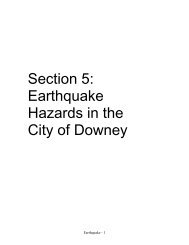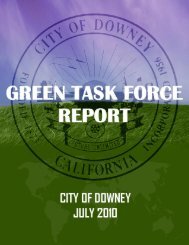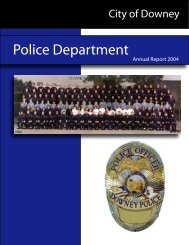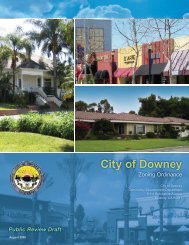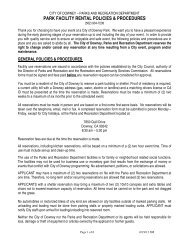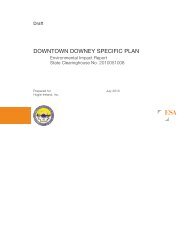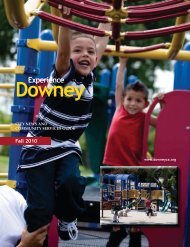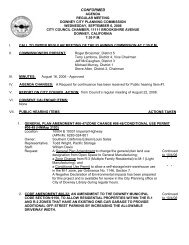CHAPTER TITLE - City of Downey
CHAPTER TITLE - City of Downey
CHAPTER TITLE - City of Downey
Create successful ePaper yourself
Turn your PDF publications into a flip-book with our unique Google optimized e-Paper software.
3. Quantified Objectives<br />
3.1 – Affordable Housing<br />
Objectives<br />
California Housing Element Law requires jurisdictions to estimate the number <strong>of</strong><br />
affordable housing opportunities that will be created over the planning period. The<br />
quantified objectives for the 2014-2021 Housing Element presents the anticipated and<br />
potential affordable housing development for the planning period starting on January<br />
1, 2014 and ending September 30, 2021.<br />
It is important to note that while the goal <strong>of</strong> the quantified objective section is to show<br />
how the <strong>City</strong> will meet its remaining RHNA allocation, and based on the premise that<br />
the <strong>City</strong> intends to make every effort to achieve these goals, <strong>Downey</strong> cannot<br />
guarantee that these needs will be met given limited financial and staff resources, and<br />
the increasing gap in affordability <strong>of</strong> housing resources and incomes. Satisfaction <strong>of</strong><br />
the <strong>City</strong>’s regional housing needs will partially depend on the cooperation <strong>of</strong> private<br />
funding sources and resources <strong>of</strong> the State, Federal and County programs that are<br />
used to support the needs <strong>of</strong> the extremely low-, very low-, low-, and moderate-income<br />
households. Additionally, outside economic forces heavily influence the housing<br />
market. State law recognizes that a locality may not be able to accommodate its<br />
regional fair share housing need.<br />
Table 3-1 presents the <strong>City</strong>’s quantified objectives in three categories: construction <strong>of</strong><br />
new affordable units, substantial rehabilitation <strong>of</strong> substandard units and the<br />
conservation <strong>of</strong> affordable housing. New construction <strong>of</strong> affordable units focuses on the<br />
<strong>City</strong>’s ability to accommodate its combined remaining RHNA allocation <strong>of</strong> 1,201units<br />
(see Table 6-4) on land identified in the sites inventory. It is important to note that this<br />
subcategory assumes optimum conditions for the production <strong>of</strong> housing and does not<br />
take into account how environmental, physical and market conditions influences the<br />
timing, type and cost <strong>of</strong> housing production in a community.<br />
In addition to new construction, the <strong>City</strong> anticipates that approximately 10 units will be<br />
assisted annually through the Housing Rebate/Senior Grant Program, as outlined in<br />
Section 2, Housing Plan. As indicated in Table 4-25 there are four ownership properties<br />
at risk <strong>of</strong> transitioning to market rate prices that the <strong>City</strong> is monitoring. In total the <strong>City</strong><br />
anticipates that approximately182 units will constructed in the upcoming planning<br />
2014- 2021 Housing Element<br />
39




